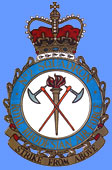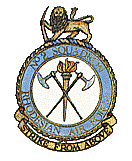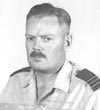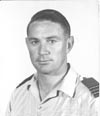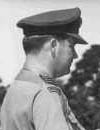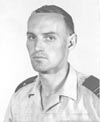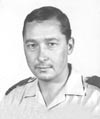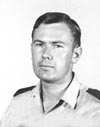Photo Gallery Top of page Air Force Home Page Site Home Page Contact Us
Formation
No 2 Squadron was formed in 1951.
Motto
"Strike from Above"
Roles
The role of No. 2 Squadron was that of flying training, ground attack in close support operations and air defence against relatively unsophisticated aircraft.
A Brief History
1951
The unit was established in 1951 to operate the second batch of Spitfire F22s that were delivered to Southern Rhodesia. It was disbanded in 1954 when the type was withdrawn from service.
1956 - 1959
In January 1956 the squadron was reformed at New Sarum Air Base, south of Salisbury, to provide flying training for new recruits. It was equipped with Vampire FB9 aircraft. It was again disbanded in June 1957.
The squadron reformed in September 1958 at Thornhill Air Base, Gwelo. The squadron provided training for new recruits using Vampire FB 9 aircraft. It was again disbanded in 1958/9.
1960
No. 2 squadron reformed in March 1960 to provide instructor training on the Provost T52 and Vampire T11. It became an advanced flying training squadron and operational conversion unit in 1963 when additional Vampire aircraft were transferred from No. 1 Squadron.
The units pilots were also tasked with internal security duties using the Provost aircraft and ground attack using the Vampires.
1963
4th February 1963 saw the fatal crash of a Percival Provost in which Flying Officer Terry Ryan died.
(See photo and brief detailsin the gallery.)
1964
In 1964 the training role was given to No. 4 Squadron and thereafter No. 2 Squadron took on the role of "Operational Conversion Training and Day Fighter/Ground Attack"
February 1964 saw the final flight of Vampire FB9 by Squadron Leader Keith Kemsley, Officer Commanding No.2 squadron, as the aircraft phased out of service. They were stored in hangars at Thornhill for many years and kept in good order.
1965
On 23rd February 1965 RRAF 414 was destroyed in an accident near Selukwe. Flight Lieutenant Tol Janeke and Officer Cadet Bill Buckle ejected safely.
1967
During August and September 1967 the squadron carried out reconnaissance flights along the countries borders. In March 1968 the squadron saw it's first action when it carried our attacks on terrorist during Operation Cauldron. These type of attacks became a regular part of the squadron activity for the remainder of the conflict.
1969
No. 2 Squadron carried out reconnaissance flights
over the western, northern and eastern borders of Rhodesia using
Vampire and Provost aircraft shared with No. 6 Squadron. The Squadron
also took over the COIN (Counter Insurgency) commitment and the defence
and ground attack role from No. 4 Squadron.
In May 1969 a Provost aircraft flew into power lines during some unauthorised
low flying. The pilot Flying Officer Rich Beaver was court marshaled
and his wing man Flying Officer Bill Sykes received a severe reprimand.
23rd July 1969 Flight Lieutenant Cyril White and Flight Lieutenant Prop Geldenhuis
during a Special Weapons Course brought back a frantan that had failed
to release. Flight Lieutenant Bob Brakewell (Thornhill armaments
officer) and three other technicians were busy taking the weapon off
the wing, whilst the aircraft was running down. The frantan was accidentally dropped onto the concrete and went off. Bob
Brakewell’s body was drenched in flames. Master Sergeant C.
McIntyre went to Bobs assistance and tried to put the flames out by
lying across his body. Both technicians sustained serious burns and
were casevaced to Salisbury by helicopter. Both survived the accident.
Master Technical Mc Intyre and Chief Technician Peter Poole were
awarded the Military Forces Commendation (Non Operational) for their
action. Bob continued to serfve the Force for some time after this
accident, in spite of serious burns.
There is a funny aside to this incident. When the Fran went off, Prop tried to cut
the fuel cock to shut the engine down, but could not pull the lever
back. His arm was supporting Cyril's weight, as Cyril stood on Prop's
arm as he went over the top, evacuating the aircraft!
1971
24th October 1971 Flight Lieutenant Chris Wentworth carried out a
wheels up landing in Vampire T11 R2424, at New Sarum. Only slight
damage was caused and the pilot was unharmed. The technicians soon had
the aircraft back in the air.
At the beginning of
November 1971 No. 2 Squadron passed its Provost aircraft (3 in number)
to No. 4 Squadron pilots who then took over the operational role of the
type, using them on COIN ops.
1972
On the 4th August 1972, a Vampire T11 crashed on the Umvuma road killing Air Sub Lieutenant David Brown. It is presumed that he tried to stretch the glide following a actual or simulated engine failure after take off but did not have enough speed to reach the runway. He chose not to eject and crashed short of the runway threshold. He lost his life trying to save a valuable aircraft.
1973
On the 4th September 1973 Air Sub Lieutenant Paddy Bate ejected from Vampire R4219 near Selukwe. The aircraft was destroyed.
1976
Flt Lt Roy Hulley was killed and the aircraft destroyed when his Vampire R1833 crashed during a low level weapons sortie at Kutanga Range.
1977
Vampire R1318 was destroyed when it crashed near Gwelo. Air Sub Lieutenant Nigel Lamb ejected safely.
On the 23rd November 1977 Air Lieutenant Phil Haig was flying on an operational sortie in the Umtali area when his aircraft was struck by ground fire. Phil elected to carry our a forced landing during which he lost his life. The aircraft was destroyed.
1978
On the 7th December 1978 Vampire R8134 was destroyed. No further information.
Post Zimbabwe Independence
In July 1982 the squadron was re-equipped with British Aerospace Hawk aircraft.
Squadron Commanders of No 2 Squadron
|
|
|
|
|
|
|
|

